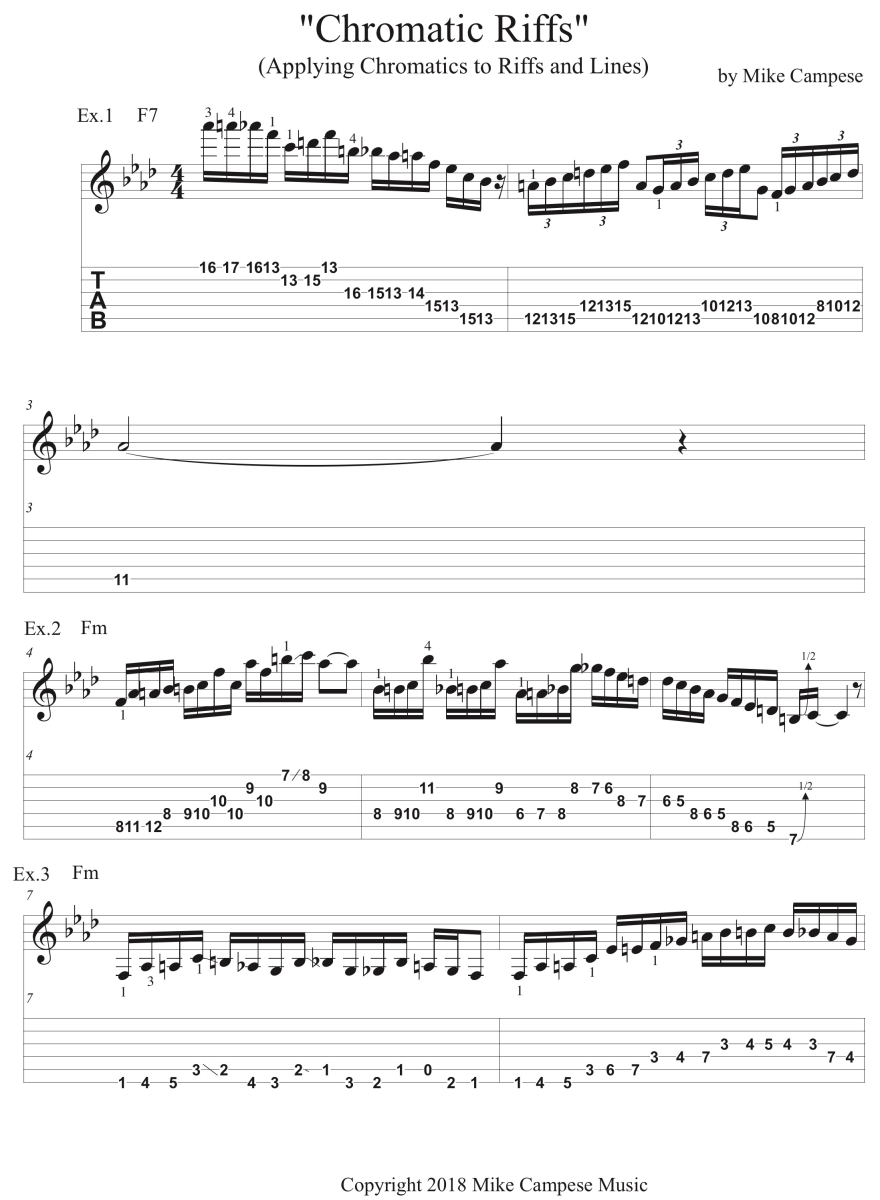Welcome back! In this lesson I will be showing you some ways to spice up your riffs, lines and solos with some chromatic passing tones. I have covered chromatics in previous lessons, but it is well worth continuing this topic. Chromatic means color and it represents additional notes that are not in the diatonic scales. They are also referred to as passing tones. By adding chromatics to your riffs and lines, it will make your playing more interesting. If you have heard people talk about playing outside in jazz and in other styles, adding chromatics can take you there. Also, this works with all types of music and it can be applied to any scale or arpeggio. Don't forget to alternate pick. Let me show you some ways I like to add chromatics.
Example 1 is a bluesy line in the key of F, and it mixes scales with chromatic passing tones. This line is based mainly on the F Mixolydian scale (F, G, A, Bb, C, D, Eb), and also on the F blues scale (F, Ab, Bb, B, C, Eb). The chromatic tones I added are mainly in bar 1 - the b3rd, Ab on beat 1 and the b5, B on beat 3. The b3 and natural 3 is very bluesy and especially adding the b5, these tones are also within those 2 scales. If you phrase it properly, you can add chromatics in a lot of places, typically on weak beats. You have to be sure to end on a scale or chord tone to be safe. Also, the 16th note triplet pattern in bar 2 adds a nice twist.
MP3 - Chromatic Riffs and Lines - Example 1
Example 2 is in Fm, which falls within the F Dorian scale (F, G, Ab, Bb, C, D, Eb) and the F blues scale, (F, Ab, Bb, b, C, Eb), with lots of chromatic tones added. Another great technique I use in this line is targeting, which is adding notes a half step above or below a chord tone or a scale tone. You can also approach these notes by a whole step or minor 3rd. In bar 1 of this example, I added the natural 3, A and the B in bar 1, that slides nicely to the C. The 2nd bar uses a lot of passing tones that connect the notes within the scale, which then it descends down the neck. The string skipping in bar 2 can be tricky, be sure to use alternate picking.
MP3 - Chromatic Riffs and Lines - Example 2
Finally, Example 3 is a fun riff that I came up with that is in Fm. It sounds great in a metal context with lots of distortion. The riff consists of minor 2nd and minor 3rd intervals, walking down to the F, and climbing up the neck. This can add a creepy effect, especially when you are moving repeated patterns down in half steps. The key is to resolve back to the root or to a chord tone - if not it may sound weird (which may be good sometimes).
MP3 - Chromatic Riffs and Lines - Example 3

OK, that is it for now! As always, make up your own lines and riffs, and be sure to visit www.mikecampese.com for the latest news, updates and album information.
Mike Campese is an all-around music performer, session artist and teacher competent in many musical styles, electric and acoustic. He has studied at G.I.T. (Honors Graduate), and with Paul Gilbert, Norman Brown, Stanley Jordan, Scott Henderson and Keith Wyatt.